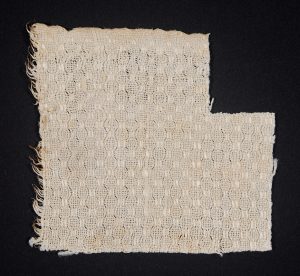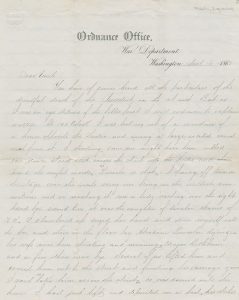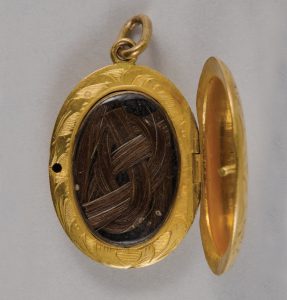By Heather Rockwood, Communications Associate
It may not seem likely that a wet-plate photograph, a towel, and a grieving widowed mother in Boston have Abraham Lincoln in common, but the following stories from the MHS collection, along with a Boston ghost story, may change your mind. Although I enjoy tales of the gruesome, grotesque, and ghostly, I know it is not for everyone: the following discusses the assassination of Abraham Lincoln and focuses on his bodily remains and his afterlife. If you choose not to read on, please have a happy Halloween!
Sitting President Abraham Lincoln was assassinated in Ford’s Theatre in Washington, D.C. by John Wilkes Booth on 14 April 1865. After Lincoln was shot, three doctors in the theatre rushed to his side and did what they could to make him comfortable as they knew the wound was mortal. They decided to carry him across the street, as a carriage ride to the White House, a fair distance from the theatre, would be too difficult for him. Several men gently lifted the president and carried him to a private house across the street from the theater. One of the men that carried Lincoln was Augustus Clark, a War Department employee, who wrote a letter to his uncle S. M. Allen of Woburn, Mass., describing what happened and enclosed within the letter a towel stained with the blood from Lincoln’s wound. Although Lincoln was shot in the head, he did not pass until 7:22 AM on 15 April 1865, the morning after he was shot.


After Lincoln passed, those around him collected pieces of cloth, hair, and other artifacts. People collected these items from Lincoln’s deathbed in part as recognition of his accomplishments as a politician and as the president, and in part because of the awareness of the historical nature of the incident. The MHS has an example in a locket made with Lincoln’s hair. This locket was donated to the MHS in 1895 from Ebenezer Rockwood Hoar, a Massachusetts congressman, who received the locket 20 years previous from a friend. The hair was collected by one of the attending physicians at Lincoln’s death and was then given to Hoar’s friend, who made it into this locket.

All so far has been somewhat normal in this recounting of the first assassination of a sitting president. However the following is much more of a ghost story. It begins in Boston with William Mumler, a Boston engraver and amateur photographer. Mumler dabbled in photography, but he is now known as being a famous spirit photographer. He first discovered the process in the early 1860s when he double exposed a glass plate while taking a self-portrait. A girl appeared behind him in the resulting print. He saw the potential in the figure, a mostly see-through specter, as if it were a ghost, and started passing it around to his friends and colleagues, saying the figure behind him was actually a cousin who had died. This story was spread around Boston, and people began to come to him for their own spirit photographs after losing a loved one.
In the 1860s many people started believing that communication with the dead was possible. The movement was called Spiritualism, and mediums, those who could “channel” the voices of, or be possessed by, the dead, would hold séances for groups to be able to witness the presence of, and hopefully communicate with, the spirits surrounding them. This form of religion gained a lot of followers in the 1860s as the Civil War escalated and the number of grieving families rose. It was especially popular in Boston and among the Boston Brahmins, as séances were known to be held in Beacon Street homes. It gained so much popularity that it also created detractors, those who would attend the séances to figure out the trickery behind them and prove the medium false.
Mary Todd Lincoln, the First Lady in the 1860s, was a Spiritualist. From 1850 to 1871, Mrs. Lincoln experienced what can be considered an excessive amount of death close to her; three sons, three brothers, her stepfather, father-in-law, a brother-in-law, and her husband. Seven of those deaths were during a nine-year period from 1862–1871. Despite being a lifelong Christian, she turned to Spiritualism after the death of her son, William, in 1862. She was inconsolable and looking for a way to manage her grief; she began attending séances and felt they were so comforting that she hosted séances in the White House.
By 1870, after being tried for fraud for his spirit photographs and then acquitted, Mumler had gained fame when Mrs. Lincoln came to Boston and sat for a Mumler spirit photograph. The resulting print showed a shadowy figure who looked like President Lincoln standing behind her with his hands on her shoulders. Peter Manseau, author of The Apparitionists: A Tale of Phantoms, Fraud, Photography, and the Man Who Captured Lincoln’s Ghost, had this to say about Mrs. Lincoln’s reaction to the photograph: “No one could dissuade her that it did not mean that Abraham Lincoln was still by her side.”
Although detractors, such as P. T. Barnum, had proven that there were many chemical and mechanical ways to create photographs with “ghosts”—with Mumler recognized today as a purveyor of hoaxes—and Spiritualist mediums were mostly proven to be false tricksters, could Abraham Lincoln have been standing with his beloved wife who had seen so much tragedy and death in her life? I like to think that Mrs. Lincoln’s photograph was perhaps the one true photograph of a ghost that Mumler captured.
If you’ve read to the end, thank you for taking this journey through Lincoln’s assassination and afterlife, and I hope you enjoy Halloween!

